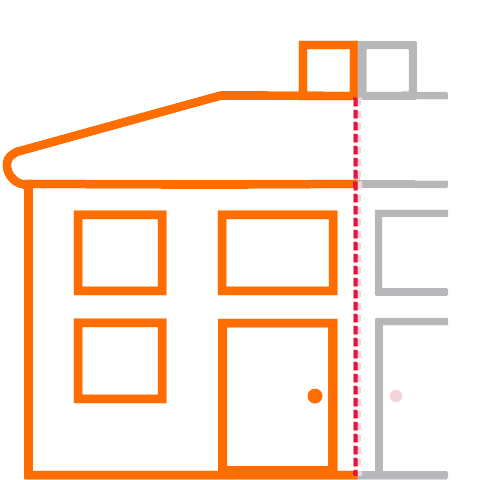When installing loft insulation, you'll need to avoid several key areas to maintain safety and efficiency. Don't cover electrical components, including wiring, junction boxes, and recessed lighting, as this creates fire hazards. Keep bathroom ventilation fans and soffit vents clear to prevent moisture buildup and mold growth. Avoid compressing insulation with storage items, as this reduces thermal performance by up to 50%. Leave water tanks and pipes accessible for maintenance, and guarantee loft hatches remain unobstructed. In eaves and low roof areas, maintain a 50mm ventilation gap for proper airflow. Understanding these critical zones will help you maximize your insulation's effectiveness while preventing potential hazards.
Electrical Wiring and Junction Boxes
Table of Contents
ToggleWhen installing loft insulation, you'll need to keep electrical components completely clear of any covering material. If you cover electrical wiring or junction boxes with insulation, you'll create a dangerous fire hazard due to heat buildup that can't properly dissipate.
You'll want to maintain clear access to all junction boxes, guaranteeing they remain easily accessible for future maintenance work or emergency repairs that might become necessary.
For recessed lighting fixtures, you must maintain a minimum clearance of 50mm between the fixture and any insulation material. This gap helps prevent dangerous heat accumulation that could potentially lead to fire risks.
You'll also need to familiarize yourself with your local building regulations, as they'll specify the exact safe distances required between insulation and various electrical components in your loft space.
Don't forget to perform regular inspections of the areas around your electrical installations, checking for any signs that the insulation has become compressed or damaged over time.
These routine checks won't just help maintain safety standards; they'll also guarantee your insulation continues to perform effectively throughout your loft space.
Recessed Light Fixtures
Recessed light fixtures demand special attention when installing loft insulation. You'll need to be particularly cautious about maintaining proper clearance around these downlights, as covering them directly with insulation creates a significant fire hazard due to trapped heat.
Building regulations require specific minimum clearance distances to guarantee your lighting fixtures operate safely and comply with fire safety standards.
To properly insulate around recessed lights, you'll want to install Loft Lid covers, which provide a protective barrier while maintaining essential airflow. These covers allow you to add insulation to your loft space without compromising the safety or functionality of your lighting system.
Without proper protection, insulation can't only create dangerous heat buildup but also reduce your lights' efficiency and lifespan.
When you're planning your loft insulation project, remember that blocked recessed fixtures will perform poorly and cost you more in energy expenses.
The reduced light output from improperly insulated fixtures means you'll likely need to use higher wattage bulbs or additional lighting to achieve the same illumination level, defeating the energy-saving purpose of your insulation efforts.
Bathroom Ventilation Fans
Similar to recessed lights, bathroom ventilation fans must remain free from loft insulation to function properly and safely. When you're adding insulation to your loft space, you'll need to maintain a clear zone around these essential ventilation fixtures, guaranteeing there's no contact between the insulating material and the fan unit or its ducting.
You'll want to keep insulation several inches away from the fan housing to allow for proper heat dissipation and airflow. If you cover or insulate these fans, you're creating conditions that can lead to serious problems: restricted airflow will reduce the fan's effectiveness, and trapped moisture can result in mold growth and potential structural damage to your loft space.
It's critical that you maintain easy access to the fan's ducting system for regular inspections and maintenance, as blockages can greatly impair the unit's performance.
To protect your home's ventilation system, you should perform periodic checks to verify that no insulation has shifted or settled against the fan units. This ongoing maintenance will help guarantee ideal air circulation and humidity control throughout your bathroom spaces.
Soffit Vents
Just as your roof needs to breathe, soffit vents play an important role in maintaining proper airflow throughout your loft space. When you're installing insulation, you'll need to make sure these vital ventilation points remain completely unobstructed, as blocking them can lead to serious consequences for your home's structure and efficiency.
You'll want to maintain a clear path around your soffit vents, as covering them with insulation creates multiple problems you'll want to avoid. When these vents become blocked, your loft space can overheat, which doesn't just compromise your insulation's effectiveness but also increases your energy costs.
Additionally, the restricted airflow often leads to condensation buildup, creating perfect conditions for mold growth and eventual deterioration of your roofing materials.
To protect your investment and maintain your loft's health, you should regularly inspect your soffit vents to make sure insulation hasn't shifted to cover them. When installing new insulation, create deliberate gaps around these vents, allowing for continuous airflow.
This attention to proper ventilation won't just preserve your roof's integrity but will also guarantee your insulation performs at its peak efficiency.
Storage Areas With Compressed Insulation
While maintaining proper ventilation is essential for your loft's health, another common mistake homeowners make involves storage areas with compressed insulation. When you store heavy items directly on top of your insulation, you're considerably compromising its thermal performance, potentially reducing its effectiveness by more than 50%.
This compression leads to unwanted heat loss through your roof and results in higher energy bills.
You'll need to be particularly careful about where you place storage items in your loft, as areas not designed to support additional weight can develop structural problems when overloaded.
To protect your insulation's performance while maintaining storage capabilities, you should consider installing raised boarding solutions like Loft Legs, which create necessary clearance above the insulation layer. This approach guarantees you're maintaining the minimum required height above the insulation material while preventing compression.
Additionally, you'll want to be mindful of maintaining proper airflow throughout your loft space. When planning your storage layout, ensure that boxes and items don't obstruct ventilation pathways, as this can impact both the insulation's performance and your loft's overall health.
Water Tanks and Pipes
Proper placement of loft insulation around water tanks and pipes requires careful consideration to prevent potential problems.
When you're installing loft insulation, you'll need to avoid covering water tanks directly, as this can interfere with their ability to retain heat and may result in freezing during cold weather conditions.
You shouldn't completely cover pipes with insulation, as you'll need to maintain access for future maintenance and repairs. Instead, you should use specially designed insulation materials that are specifically made for water tanks and pipe areas, ensuring they provide adequate thermal protection while maintaining necessary accessibility.
It's crucial to create proper ventilation around these elements to prevent moisture accumulation and condensation issues, which can lead to long-term damage.
You'll want to establish a regular inspection routine to check that the insulation around your water tanks and pipes hasn't become compressed or shifted out of position.
If you notice any signs of compression or displacement, you should address these issues promptly, as they can greatly reduce the insulation's effectiveness and potentially lead to problems with your water system during colder months.
Loft Hatches and Access Points
Similar to protecting water systems, maintaining clear access to your loft space requires strategic insulation placement.
When you're insulating your loft, you'll need to pay special attention to how you handle the areas around access points and hatches, as improper installation can create significant safety risks and maintenance challenges.
You shouldn't place insulation directly over your loft hatch, as this can make it difficult to enter the space and potentially create hazardous conditions.
Instead, you'll want to maintain a clear gap around the hatch edges, which helps prevent heat loss while ensuring proper ventilation. A practical solution is to install a Loft Lid cover, which provides effective insulation while maintaining easy access to your loft space.
When you're working around access points, it's essential to use appropriate insulation materials that won't interfere with the opening and closing of hatches.
This approach allows you to maintain the thermal efficiency of your loft while ensuring you can still perform regular inspections and maintenance.
Remember that blocked access points can make it challenging to monitor the condition of your insulation and address any issues that might arise over time.
Eaves and Low Roof Areas
Loft insulation commonly fails when installed incorrectly in eaves and low roof areas. When you're installing insulation in these vital zones, you'll need to be particularly mindful of maintaining proper airflow and preventing moisture accumulation, which can lead to serious problems if not addressed correctly.
You shouldn't completely block your eaves with insulation, as this disrupts essential ventilation pathways. If you're insulating these areas, you must maintain a minimum 50mm ventilation gap to guarantee adequate airflow and prevent moisture from becoming trapped.
In low roof sections, where space is limited, you'll find that compressed insulation becomes markedly less effective, potentially losing up to half of its thermal performance capabilities.
When working near soffit vents, you'll need to keep them completely clear of any insulation material. These vents play a key role in your loft's ventilation system, and blocking them can result in condensation issues and potential mold growth.
If you're uncertain about proper installation in these areas, it's worth consulting a professional to verify you're maintaining the delicate balance between insulation effectiveness and proper ventilation.





